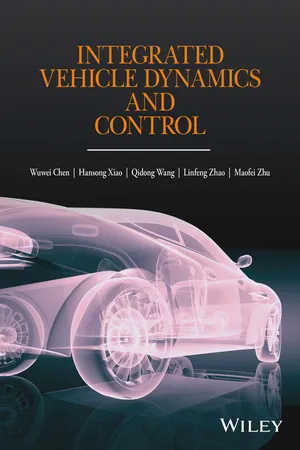
Integrated Vehicle Dynamics and Control
- English
- ePUB (mobile friendly)
- Available on iOS & Android
Integrated Vehicle Dynamics and Control
About this book
A comprehensive overview of integrated vehicle system dynamics exploring the fundamentals and new and emerging developments
This book provides a comprehensive coverage of vehicle system dynamics and control, particularly in the area of integrated vehicle dynamics control. The book consists of two parts, (1) development of individual vehicle system dynamic model and control methodology; and (2) development of integrated vehicle dynamic model and control methodology. The first part focuses on investigating vehicle system dynamics and control according to the three directions of vehicle motions, including longitudinal, vertical, and lateral. Corresponding individual control systems, e.g. Anti-lock Brake System (ABS), Active Suspension, Electric Power Steering System (EPS), are introduced and developed respectively.
Particular attention is paid in the second part of the book to develop integrated vehicle dynamic control system. Integrated vehicle dynamics control system is an advanced system that coordinates all the chassis control systems and components to improve the overall vehicle performance including safety, comfort, and economy. Integrated vehicle dynamics control has been an important research topic in the area of vehicle dynamics and control over the past two decades. The research topic on integrated vehicle dynamics control is investigated comprehensively and intensively in the book through both theoretical analysis and experimental study. In this part, two types of control architectures, i.e. centralized and multi-layer, have been developed and compared to demonstrate their advantages and disadvantages.
- Integrated vehicle dynamics control is a hot topic in automotive research; this is one of the few books to address both theory and practice of integrated systems
- Comprehensively explores the research area of integrated vehicle dynamics and control through both theoretical analysis and experimental study
- Addresses a full range of vehicle system topics including tyre dynamics, chassis systems, control architecture, 4 wheel steering system and design of control systems using Linear Matrix Inequality (LMI) Method
Frequently asked questions
- Essential is ideal for learners and professionals who enjoy exploring a wide range of subjects. Access the Essential Library with 800,000+ trusted titles and best-sellers across business, personal growth, and the humanities. Includes unlimited reading time and Standard Read Aloud voice.
- Complete: Perfect for advanced learners and researchers needing full, unrestricted access. Unlock 1.4M+ books across hundreds of subjects, including academic and specialized titles. The Complete Plan also includes advanced features like Premium Read Aloud and Research Assistant.
Please note we cannot support devices running on iOS 13 and Android 7 or earlier. Learn more about using the app.
Information
1
Basic Knowledge of Vehicle System Dynamics
1.1 Traditional Methods of Formulating Vehicle Dynamics Equations
- Generalized coordinates Any set of parameters that uniquely define the configuration (position and orientation) of the system relative to the reference configuration is called a set of generalized coordinates. Generalized coordinates may be dependent or independent. To a system in motion, the generalized coordinates that specify the system may vary with time. In this text, column vectoris used to designate generalized coordinates, where n is the total number of generalized coordinates.
 In Cartesian coordinates, to describe a planar system which consists of b bodies,coordinates are needed. For a spatial system with b bodies,
In Cartesian coordinates, to describe a planar system which consists of b bodies,coordinates are needed. For a spatial system with b bodies, (or
(or ) coordinates are needed.
) coordinates are needed. The overall vector of coordinates of the system is denoted by, where vector qi is the vector of coordinates for the ith body in the system.
The overall vector of coordinates of the system is denoted by, where vector qi is the vector of coordinates for the ith body in the system.
- Constraints and constraint equations Normally, a mechanical system that is in motion can be subjected to some geometry or movement restrictions. These restrictions are called constraints. When these restrictions are expressed as mathematical equations, they are referred to as constraint equations. Usually these constraint equations are denoted as follows:(1.1)
 If the time variable appears explicitly in the constraint equations, they are expressed as:(1.2)
If the time variable appears explicitly in the constraint equations, they are expressed as:(1.2)
- Holonomic constraints and nonholonomic constraints Holonomic and nonholonomic constraints are classical mechanics concepts that are used to classify constraints and systems. If constraint equations do not contain derivative terms, or the derivative terms are integrable, these constraints are said to be called holonomic. They are geometric constraints. However, if the constraint equations contain derivative terms that are not integrable in closed form, these constraints are said to be nonholonomic. They are movement constraints, such as the velocity or acceleration conditions imposed on the system.
- Degrees of freedom The generalized coordinates that satisfy the constraint equations in a system may not be independent. Thus, the minimum number of coordinates required to describe the system is called the number of degrees of freedom (DOF).
- Virtual displacement Virtual displacement is an assumed infinitesimal displacement of a system at a certain position with constraints satisfied while time is held constant. Conditions imposed on the virtual displacement by the constraint equations are called virtual displacement equations. A virtual displacement may be a linear or an angular displacement, and it is normally denoted by the variational symbol δ. Virtual displacement is a different concept from actual displacement. Actual displacement can only take place with the passage of time; however, virtual displacement has nothing to do with any other c...
Table of contents
- Cover
- Title Page
- Table of Contents
- Preface
- 1 Basic Knowledge of Vehicle System Dynamics
- 2 Tyre Dynamics
- 3 Longitudinal Vehicle Dynamics and Control
- 4 Vertical Vehicle Dynamics and Control
- 5 Lateral Vehicle Dynamics and Control
- 6 System Coupling Mechanism and Vehicle Dynamic Model
- 7 Integrated Vehicle Dynamics Control
- 8 Integrated Vehicle Dynamics Control
- 9 Perspectives
- Index
- End User License Agreement